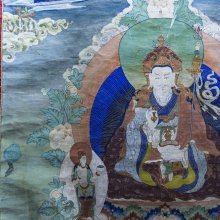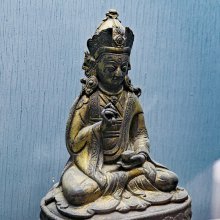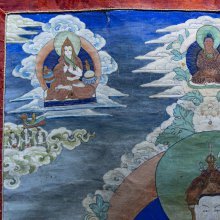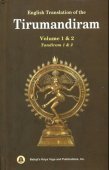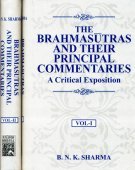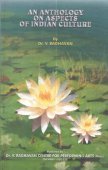Guru: 50 definitions
Introduction:
Guru means something in Buddhism, Pali, Hinduism, Sanskrit, Jainism, Prakrit, the history of ancient India, Marathi, Hindi, biology. If you want to know the exact meaning, history, etymology or English translation of this term then check out the descriptions on this page. Add your comment or reference to a book if you want to contribute to this summary article.
Images (photo gallery)
(+13 more images available)
In Hinduism
Shaivism (Shaiva philosophy)
Source: bhagavadgitausa.com: Kashmir SaivismGuru is Brahma, Vishnu and Siva all rolled into one. Guru is Gu and Ru; Gu is darkness and Ru is remover. Guru dispels darkness, sin, and ignorance. Once Guru purifies himself both externally and internally and assumes the body of the deity he worships and propitiates, the body of the Guru is the same as the deity; his disciple receives a bit of the effulgence from the grace of the Guru. Initiation by mind (manasi Diksa is the best of all Diksas. I will give you an idea of external purification of the body that the disciple should undergo at the beginning. He awakens in the morning; clears his mind of all impure thoughts; scrapes the coated tongue, cleans the mouth and face, and takes a bath.
In Kashmir Saivism Guru is not necessary for initiation. Abhi says that by acquiring Pratyabhijna, one can bypass Guru initiation. When all the Malas are removed, Spiritual knowledge descends into the soul of the individual and that is called SaktipAta, also called Sattinipatam (ºò¾¢¿¢À¡¾õ) in Saiva Siddhanta of Tamil Nadu.

Shaiva (शैव, śaiva) or Shaivism (śaivism) represents a tradition of Hinduism worshiping Shiva as the supreme being. Closely related to Shaktism, Shaiva literature includes a range of scriptures, including Tantras, while the root of this tradition may be traced back to the ancient Vedas.
Natyashastra (theatrics and dramaturgy)
Source: Wisdom Library: Nāṭya-śāstra1) Guru (गुरु) is the name of a meter belonging to the Pratiṣṭhā or Supratiṣṭhā class of Dhruvā (songs) described in the Nāṭyaśāstra chapter 32:—“the metre which has in its feet of five syllables the first, the third and the last long, is guru”.
2) Guru (गुरु) or Gurusaṃyoga or Gurusañcaya refers to one of the three yogas or saṃyogas: rules used in the playing of drums (puṣkara) [with reference to Mṛdaṅga, Paṇava and Dardura] according to the Nāṭyaśāstra chapter 33. Accordingly, “the guru-sañcaya is in heavy syllables, slow tempo and ogha-pravṛtti e.g., gheto ketaṃ candrāṃ khetaṃ dvaṃ dvam khetaṃ dhvaṃ dvaṃ dvaṃ drāghetaṃ battaṃ khettaṃ”.
Source: WikiPedia: NatyashastraSyllables in a pada are also classified as metrically short (laghu "light") or long (guru "heavy"): a syllable is metrically short only if it contains a short vowel and is not followed by consecutive consonants in the same pada. All other syllables are long, by quality (having a long vowel or diphthong) or by position (being followed by a consonant cluster).

Natyashastra (नाट्यशास्त्र, nāṭyaśāstra) refers to both the ancient Indian tradition (shastra) of performing arts, (natya—theatrics, drama, dance, music), as well as the name of a Sanskrit work dealing with these subjects. It also teaches the rules for composing Dramatic plays (nataka), construction and performance of Theater, and Poetic works (kavya).
Purana and Itihasa (epic history)
Source: Wisdom Library: Bhagavata PuranaGuru (गुरु):—One of the two sons of Saṅkṛti (son of Nara, who was one of the five sons of Manyu). (see Bhāgavata Purāṇa 9.21.2)
Source: archive.org: Puranic EncyclopediaGuru (गुरु).—The following five persons are to be considered as gurus: Father, mother, Preceptor, Agni (Fire) and Ātman (soul), (Śloka 27, Chapter 214, Vana Parva).
Source: archive.org: Shiva Purana - English TranslationGuru (गुरु) refers to an “elder” or “preceptor”, as mentioned in the Śivapurāṇa-māhātmya chapter 6.—Accordingly, “either as the cause of birth or of attributes there are many who may be termed “Guru” (elder, preceptor). Among them the Purāṇic scholar is the greatest Guru. Who can be a greater Guru than the person who bestows the highest salvation on those who are disheartened due to the millions of births?”.
Guru refers to “preceptor” in Śivapurāṇa 1.18. Accordingly, “[...] the word Guru (preceptor) signifies a person who wards off bad qualities. He removes all the ill effects of the Rājasaic qualities. He is supreme Śiva himself. He is beyond the three Guṇas, and assuming the form of the preceptor removes the ill effects of the three Guṇas and makes the disciple understand Śiva. Hence he is the preceptor of the disciples who have faith. [...] The real father, the physical begetter, drowns the son in the ocean of worldly existence. But the preceptor (Guru), the giver of knowledge, the father of learning enables him to cross that ocean. The disciple shall realise the difference between the two and worship the preceptor sincerely”.
Source: Cologne Digital Sanskrit Dictionaries: The Purana Index1a) Guru (गुरु).—A son of Samkṛti.*
- * Bhāgavata-purāṇa XI. 21. 2.
1b) A son of Bhautya Manu.*
- * Brahmāṇḍa-purāṇa IV. 1. 114. Vāyu-purāṇa 110. 51.
1c) Devotion to, praised by Kaca; his daughter cannot be married by a pupil, as she stands in relation of a sister.1 Guru (śuśrūṣa) service of the teacher pleases Hari. Kṛṣṇa's discourse on service to guru, and his tribute to his teacher Sāndīpāni. It is said that guru's blessings make a man rise to his full stature.2 Different kinds of guru—mahāguru, ācārya, deśīka and others.3 Implicit obedience to. Transgressing his orders leads one to be born an aerial spirit: fit to be honoured like a king and a god.4
- 1) Matsya-purāṇa 25. 69; 26. 6-8, 12-16.
- 2) Bhāgavata-purāṇa X. 80. 28-43.
- 3) Brahmāṇḍa-purāṇa IV. 8. 3-6.
- 4) Ib. 43. 37-59.
1d) The planet Bṛhaspati.*
- * Matsya-purāṇa 93. 14.
1e) A sage.*
- * Matsya-purāṇa 196. 45.

The Purana (पुराण, purāṇas) refers to Sanskrit literature preserving ancient India’s vast cultural history, including historical legends, religious ceremonies, various arts and sciences. The eighteen mahapuranas total over 400,000 shlokas (metrical couplets) and date to at least several centuries BCE.
Ayurveda (science of life)
Nighantu (Synonyms and Characteristics of Drugs and technical terms)
Source: WorldCat: Rāj nighaṇṭuGuru (गुरु) is another name for Kapikacchu, a medicinal plant identified with Mucuna pruriens (velvet bean or cowhage or cowitch) from the Fabaceae or “bean family” of flowering plants, according to verse 3.50-53 of the 13th-century Raj Nighantu or Rājanighaṇṭu. The third chapter (guḍūcyādi-varga) of this book contains climbers and creepers (vīrudh). Together with the names Guru and Kapikacchu, there are a total of twenty-six Sanskrit synonyms identified for this plant.
Unclassified Ayurveda definitions
Source: Wisdom Library: Āyurveda and botanyGuru (गुरु, “heavy”).—One of the twenty Gurvādiguṇa, or, ‘ten opposing pairs of qualities of drugs’.—Guru is the characteristic of a drug referring to its ‘heaviness’, while its opposing quality, Laghu, refers to its ‘lightness’. It is a Sanskrit technical term from Āyurveda (Indian medicine) and used in literature such the Caraka-saṃhitā and the Suśruta-saṃhitā.
The quality of Guru, present in drugs and herbs, increases the Kapha (bodily fluids, or ‘phlegm’), while it aggrevates the Vāta (bodily humour in control of motion and the nervous system) and the Pitta (bodily humour in control of digestion and metabolism). It exhibits a predominant presence of the elements Earth (pṛthivī) and Water (ap).
Source: archive.org: Vagbhata’s Ashtanga Hridaya Samhita (first 5 chapters)Guru (गुरु) refers to the “heavy” (e.g., water), as mentioned in verse 5.6-8 of the Aṣṭāṅgahṛdayasaṃhitā (Sūtrasthāna) by Vāgbhaṭa.—Accordingly, “[...] Not shall one drink (water that is) turbid [viz., āvila] and covered with mud, tape-grass, grass, and leaves, unseen by sun, moon, and wind, rained upon, thick, heavy [viz., guru], [...]: (such water) one shall not drink”.
Source: gurumukhi.ru: Ayurveda glossary of termsGurū (गुरू):—1. heavy / heaviness; one among 20 guravdi guna. caused due to activated prithvi & jala mahabhuta; denotes physiological & pharmacological heaviness; manifested by causing heaviness in the living system, difficult to digest, diminshes the agni(digestive & metabolic enzymes), increases all body tissues, pacifies vata, increases kapha; excessive use can cause fatigue, obesity. 2. synonym of Kapikachhu (Mucuna pruritus Linn. ) 3. A spiritual parent or preceptor
Source: National Mission for Manuscripts: Traditional Medicine System in IndiaGuru (गुरु, “heavy”) and Laghu (“light”) refers to one of the ten counterpart-couples of the twenty Śārīraguṇa (or Gurvādiguṇa), which refers to the “twenty qualities of the body”—where guṇa (property) represents one of the six divisions of dravya (drugs).—Śārīraka-guṇas are twenty in number. There are ten guṇas with their opposite guṇas. [...] Guru (“heavy”) has the predominant bhūta (element) of earth, water and the associated actions of “building/bṛṃhaṇa”; while Laghu (“light”) has the predominant bhūta (element) of fire, air, ether, space and is associated with the action “reducing/laṅghana”.

Āyurveda (आयुर्वेद, ayurveda) is a branch of Indian science dealing with medicine, herbalism, taxology, anatomy, surgery, alchemy and related topics. Traditional practice of Āyurveda in ancient India dates back to at least the first millenium BC. Literature is commonly written in Sanskrit using various poetic metres.
Vastushastra (architecture)
Source: Wisdom Library: Vāstu-śāstraGuru (गुरु, “thursday”) corresponds with jupiter and refers to the fifth of seven vāra (days), according to the Mānasāra. Vāra is the fifth of the āyādiṣaḍvarga, or “six principles” that constitute the “horoscope” of an architectural or iconographic object. Their application is intended to “verify” the measurements of the architectural and iconographic object against the dictates of astrology that lay out the conditions of auspiciousness.
The particular day, or vāra (e.g., guru) of all architectural and iconographic objects (settlement, building, image) must be calculated and ascertained. This process is based on the principle of the remainder. An arithmetical formula to be used in each case is stipulated, which engages one of the basic dimensions of the object (breadth, length, or perimeter/circumference). Among these vāras, Guru (Thursday), Śukra (Friday), Budha (Wednesday) and Śaśi or Candra (Monday), are considered auspicious and therefore, to be preferred. The text states, however, that the inauspiciousness of the other three days are nullified if there occurs a śubhayoga, “auspicious conjunction (of planets)” on those days.

Vastushastra (वास्तुशास्त्र, vāstuśāstra) refers to the ancient Indian science (shastra) of architecture (vastu), dealing with topics such architecture, sculpture, town-building, fort building and various other constructions. Vastu also deals with the philosophy of the architectural relation with the cosmic universe.
Arthashastra (politics and welfare)
Source: Shodhganga: Kakati Ganapatideva and his times (artha)Guru (गुरु, “preceptor”) is an official title designating one of the seventy-two officers (niyoga) of the Bāhattaraniyogādhipati circle, according to the Inscriptional glossary of Andhra Pradesh (Śāsana-śabdakośāmu). The bāhattaraniyoga-adhipati is the highest executive officer of this circle (including a Guru). For example: During the reign of Gaṇapatideva, the area extending between Pānagal to Mārjavāḍi was entrusted to Gaṇḍapeṇḍāru Gangayasāhiṇi as Bāhattaraniyogādhipati. Later on, this office was entrusted to Kāyastha Jannigadeva.

Arthashastra (अर्थशास्त्र, arthaśāstra) literature concerns itself with the teachings (shastra) of economic prosperity (artha) statecraft, politics and military tactics. The term arthashastra refers to both the name of these scientific teachings, as well as the name of a Sanskrit work included in such literature. This book was written (3rd century BCE) by by Kautilya, who flourished in the 4th century BCE.
Vyakarana (Sanskrit grammar)
Source: Wikisource: A dictionary of Sanskrit grammar1) Guru (गुरु).—Possessed of a special effort as opposed to लघु (laghu); cf. तद् गुरु भवति (tad guru bhavati) M. Bh. Ahnika 1। (|)
2) Guru.—Heavy, a technical term including दीर्घ (dīrgha) (long) vowel as also a ह्रस्व (hrasva) (short) vowel when it is followed by a conjunct consonant, (cf. संयोगे गुरु । दीर्घ च। (saṃyoge guru | dīrgha ca|) P. I. 4.11, 12) or a consonant after which the word terminates or when it (the vowel) is nasalized; cf. Tai. Pr. XXII. 14, cf. also R. Pr. I. 5.

Vyakarana (व्याकरण, vyākaraṇa) refers to Sanskrit grammar and represents one of the six additional sciences (vedanga) to be studied along with the Vedas. Vyakarana concerns itself with the rules of Sanskrit grammar and linguistic analysis in order to establish the correct context of words and sentences.
Chandas (prosody, study of Sanskrit metres)
Source: Shodhganga: a concise history of Sanskrit Chanda literatureGuru (गुरु) or Ga refers to the dīrgha (long) letter in a verse.— The whole chanda literature has several technical terms, by which it is controlled. Single letters are used to denote a specific instance. The letter ga stands for guru letter while the letter la stands for laghu letter. In a verse the letter which is guru is also known as dīrgha (long) and which is laghu is also known as hrasva (short). The dīrgha letter consists of two mātrās while the hrasva letter consists of one mātrā.
Guru symbols can be identified as the shape of tāṭaṅka, hāra or keyūra, and the laghu can be identified as menu, kāhāla (daṇḍa) or śara.

Chandas (छन्दस्) refers to Sanskrit prosody and represents one of the six Vedangas (auxiliary disciplines belonging to the study of the Vedas). The science of prosody (chandas-shastra) focusses on the study of the poetic meters such as the commonly known twenty-six metres mentioned by Pingalas.
Jyotisha (astronomy and astrology)
Source: Pt. Sanjay Rath: Bṛhaspati Kavacha MantraGuru (गुरु) refers to one of the 18 names of Jupiter (Bṛhaspati) according to the Bṛhaspati-kavaca-mantra from the Brahmayāmalatantra. In jyotiṣa there is a saying that when Jupiter protects there is none that can destroy. The eighteen names of Jupiter (viz., Guru) relate to eighteen body parts starting from the top of head (śiras). One method uses this formula: Each name associates with two drekkāṇa reckoned from lagna in the horoscope.

Jyotisha (ज्योतिष, jyotiṣa or jyotish) refers to ‘astronomy’ or “Vedic astrology” and represents the fifth of the six Vedangas (additional sciences to be studied along with the Vedas). Jyotisha concerns itself with the study and prediction of the movements of celestial bodies, in order to calculate the auspicious time for rituals and ceremonies.
Dharmashastra (religious law)
Source: Knowledge Traditions & Practices of India: Education: Systems & PracticesGuru (गुरु, “teacher”) forms part of the ancient Indian education system, which aimed at both the inner and the outer dimension of a person. A given teacher-student relationship obtained in Indian culture. The teacher, the Guru, the Ācārya, was highly honoured and was seen as the guide who helped students escape the darkness of ignorance and attain the light of knowledge. The teacher’s house was the centre of the ācāryakula, the gurukula. The student and the teacher had a symbiotic relationship and students were treated as members of the teacher’s family.

Dharmashastra (धर्मशास्त्र, dharmaśāstra) contains the instructions (shastra) regarding religious conduct of livelihood (dharma), ceremonies, jurisprudence (study of law) and more. It is categorized as smriti, an important and authoritative selection of books dealing with the Hindu lifestyle.
Vaishnavism (Vaishava dharma)
Source: Pure Bhakti: Bhagavad-gita (4th edition)Guru (गुरु) refers to “(1) Spiritual master (2) Guru means ‘heavy with realization of divine knowledge’. By steadiness, the guru anchors the disciple’s restless mind from the turbulent waters of the material energy. Literally, gu–‘ignorance’, ru–‘he who dispels’. One who is guru will dispel all ignorance”. (cf. Glossary page from Śrīmad-Bhagavad-Gītā).
Source: Pure Bhakti: Arcana-dipika - 3rd EditionGuru (गुरु) is “a manifestation of Śrī Hari and non-different from Him”, according to the Arcana-dīpikā (manual on deity worship).—Bhagavān Śrī Hari Himself is the guru of all jīvas. If the Guru is pleased with someone, Śrī Bhagavān will also be pleased with that person. If Bhagavān is displeased with someone, he can still be protected by a bona fide Guru, but if the guru is displeased with someone, then even Śrī Bhagavān cannot protect him.
Gurus are of three categories:
- śravaṇa-guru (the person from whom one hears knowledge of the bhaktas, bhakti and bhagavat-tattva),
- dīkṣā-guru (one who gives a mantra for worship according to the rules and regulations of scripture),
- śikṣā-guru (one who gives instructions in bhajana).
By taking shelter of the lotus feet of a bona fide Guru, a jīva can achieve the topmost goal (parama-puruṣārtha). Those who have taken shelter at the lotus feet of a bona fide Guru and received dīkṣā from him realize that Śrī Bhagavān is the Supreme Lord and everyone’s worshipable deity.
Source: Pure Bhakti: Brhad BhagavatamrtamGuru (गुरु) refers to:—Spiritual master. (cf. Glossary page from Śrī Bṛhad-bhāgavatāmṛta).

Vaishnava (वैष्णव, vaiṣṇava) or vaishnavism (vaiṣṇavism) represents a tradition of Hinduism worshipping Vishnu as the supreme Lord. Similar to the Shaktism and Shaivism traditions, Vaishnavism also developed as an individual movement, famous for its exposition of the dashavatara (‘ten avatars of Vishnu’).
Vedanta (school of philosophy)
Source: Shodhganga: Siva Gita A Critical StudyGuru (गुरु) or Gurugītā refers to one of the sixty-four Gītās commonly referred to in Hindu scriptures.—Gītā is the name given to certain sacred writings in verse (often in the form of a dialogue) which are devoted to the exposition of particular religious and theosophical doctrines. Most of these Gītās [i.e., Guru-gītā] originate from the Mahābhārata or the various Purāṇas.

Vedanta (वेदान्त, vedānta) refers to a school of orthodox Hindu philosophy (astika), drawing its subject-matter from the Upanishads. There are a number of sub-schools of Vedanta, however all of them expound on the basic teaching of the ultimate reality (brahman) and liberation (moksha) of the individual soul (atman).
Shaktism (Shakta philosophy)
Source: Google Books: ManthanabhairavatantramGuru (गुरु) refers to “master” (e.g, guruśiṣya—master and disciple), according to the second recension of the Yogakhaṇḍa of the Manthānabhairavatantra, a vast sprawling work that belongs to a corpus of Tantric texts concerned with the worship of the goddess Kubjikā.—Accordingly, as the Goddess (i.e., Kumārī) said to the God (i.e., Bhairava), “[...] Accomplishment is achieved in a special way by the transmission that takes place from master to disciple [i.e., guru-śiṣya-krama]. You are my Lord, so how can you relate (to me as my) disciple? O Mahādeva, you are omniscient; how can you (assume the role of a) disciple? Bearing this in mind, tell me what would be best, and free of fear”.

Shakta (शाक्त, śākta) or Shaktism (śāktism) represents a tradition of Hinduism where the Goddess (Devi) is revered and worshipped. Shakta literature includes a range of scriptures, including various Agamas and Tantras, although its roots may be traced back to the Vedas.
General definition (in Hinduism)
Source: Google Books: Understanding MantrasThe Lakṣmī Tantra (13.34) asserts that a guru, irrespective of his sect or creed, is a manifestation of Śakti’s aspect as savior. He is like a doctor who knows the exact treatment for his disciple’s ailment, the bondage of saṃsāra. He holds the key to the mysteries of the scriptures; he is the repository of the secret lore of the mantras and their applications in ritual and meditation.
Source: Alexis Sanderson: The Śaiva LiteratureA Guru (गुरु) is one who conveys the meaning [of the text to] his pupils in whatever manner is appropriate to them, using Sanskrit, Prakrit, or such means as the regional languages. (see the Śivadharmottara 2.3)
Source: DSpace at Pondicherry: Siddha Cult in Tamilnadu (hinduism)Guru (गुरु).—The Pārānandasūtra prescribes that the disciple has to undergo dīkṣā or initiation from a qualified guru, who should preferably be jīvan-mukta, i.e., one who is liberated and is not tainted in any way. The preceptor should collect the materials of the five makāras and hand over to the disciple a bowl for drinking wine, mudrā (fried cereal), and a woman (generally a courtesan).
In Buddhism
Tibetan Buddhism (Vajrayana or tantric Buddhism)
Source: academia.edu: The Structure and Meanings of the Heruka MaṇḍalaGuru (गुरु) refers to one of the eight direction-guardians (dikpāla) of the Jñānacakra, according to the 10th century Ḍākārṇava chapter 15. Accordingly, the jñānacakra refers to one of the three divisions of the saṃbhoga-puṭa (‘enjoyment layer’), situated in the Herukamaṇḍala. Guru is associated with the charnel ground (śmaśāna) named Dhūmāndhakāra and with the tree (vṛkṣa) named Nāgakesara.

Tibetan Buddhism includes schools such as Nyingma, Kadampa, Kagyu and Gelug. Their primary canon of literature is divided in two broad categories: The Kangyur, which consists of Buddha’s words, and the Tengyur, which includes commentaries from various sources. Esotericism and tantra techniques (vajrayāna) are collected indepently.
General definition (in Buddhism)
Source: Wisdom Library: BuddhismGuru:—A Dharma teacher in the Tibetan tradition.
In Jainism
General definition (in Jainism)
Source: Encyclopedia of Jainism: Tattvartha Sutra 8: Bondage of karmasGuru (गुरु, “cold”) refers to one of the eight types of Sparśa (touch), representing one of the various kinds of Nāma, or “physique-making (karmas)”, which represents one of the eight types of Prakṛti-bandha (species bondage): one of the four kinds of bondage (bandha) according to the 2nd-century Tattvārthasūtra chapter 8. The karmas rise of which gives the touch attribute to the body are called touch (sparśa) body-making karma (e.g., guru).
Source: The University of Sydney: A study of the Twelve ReflectionsGuru (गुरु) refers to “heavy (feet)”, according to the 11th century Jñānārṇava, a treatise on Jain Yoga in roughly 2200 Sanskrit verses composed by Śubhacandra.—Accordingly, “This world totters to the limit of the world of Brahmā with the fear of the beginning of a frown, and mountains immediately fall asunder by force of [the fact that] the earth is overcome by the weight of the heavy feet (guru—caraṇagurubharākrāntadhātrīvaśena), of those heroes who are all led to death by the king of time in [the space of] some days. Nevertheless, desire is intense only in a living being who is bereft of sense”.
Synonyms: Gariṣṭha, Hitopadeṣṭṛ.

Jainism is an Indian religion of Dharma whose doctrine revolves around harmlessness (ahimsa) towards every living being. The two major branches (Digambara and Svetambara) of Jainism stimulate self-control (or, shramana, ‘self-reliance’) and spiritual development through a path of peace for the soul to progess to the ultimate goal.
India history and geography
Source: Cologne Digital Sanskrit Dictionaries: Indian Epigraphical GlossaryGuru.—(SII 1), a preceptor; also ‘the head’ as in Caṇḍik- āśrama-guru. Note: guru is defined in the “Indian epigraphical glossary” as it can be found on ancient inscriptions commonly written in Sanskrit, Prakrit or Dravidian languages.

The history of India traces the identification of countries, villages, towns and other regions of India, as well as mythology, zoology, royal dynasties, rulers, tribes, local festivities and traditions and regional languages. Ancient India enjoyed religious freedom and encourages the path of Dharma, a concept common to Buddhism, Hinduism, and Jainism.
Biology (plants and animals)
Source: Wisdom Library: Local Names of Plants and DrugsGuru in the Hindi language is the name of a plant identified with Alternanthera sessilis (L.) R.Br. ex DC. from the Amaranthaceae (Amaranth) family. For the possible medicinal usage of guru, you can check this page for potential sources and references, although be aware that any some or none of the side-effects may not be mentioned here, wether they be harmful or beneficial to health.
Source: Google Books: CRC World Dictionary (Regional names)Guru in India is the name of a plant defined with Ficus religiosa in various botanical sources. This page contains potential references in Ayurveda, modern medicine, and other folk traditions or local practices It has the synonym Urostigma religiosum Gasp. (among others).
Example references for further research on medicinal uses or toxicity (see latin names for full list):
· FBI (1888)
· Ric. Caprifico (1845)
· Numer. List (4493)
· London Journal of Botany (1848)
· Enum. Hort. Berol. Alt. (1822)
· Bot. Mat. Med. (1812)
If you are looking for specific details regarding Guru, for example pregnancy safety, diet and recipes, extract dosage, health benefits, side effects, chemical composition, have a look at these references.

This sections includes definitions from the five kingdoms of living things: Animals, Plants, Fungi, Protists and Monera. It will include both the official binomial nomenclature (scientific names usually in Latin) as well as regional spellings and variants.
Languages of India and abroad
Pali-English dictionary
Source: BuddhaSasana: Concise Pali-English Dictionaryguru : (m.) a teacher. (adj.), heavy; venerable.
Source: Sutta: The Pali Text Society's Pali-English DictionaryGuru, (adj.-n.) (a younger form of garu (q. v.); Sk. guru) venerable, reverend, a teacher VvA.229, 230 (°dakkhiṇā a teacher’s fee); PvA.3 (°janā venerable persons); Sdhp.227 (°ûpadesa), 417. (Page 253)

Pali is the language of the Tipiṭaka, which is the sacred canon of Theravāda Buddhism and contains much of the Buddha’s speech. Closeley related to Sanskrit, both languages are used interchangeably between religions.
Marathi-English dictionary
Source: DDSA: The Molesworth Marathi and English Dictionaryguru (गुरु).—m (S) A spiritual parent; the conductor of the various ceremonies necessary during infancy and youth, up to the period of investiture with the sacred thread. 2 A religious teacher; one who instructs in the Shastras. Hence (fig. and in a bad sense) One who prompts, puts up to, abets. 3 A father or any venerable male relation. 4 A name of bṛhaspati, the Guru of the gods and Regent of the planet Jupiter. 5 The planet Jupiter. 6 A pimple of the small-pox inflamed by scratching.
--- OR ---
guru (गुरु).—a (S) Heavy or weighty. 2 Great or large. 3 Heavy of digestion. 4 Long; having a sound equal to two matra or simple sounds--a vowel. 5 Difficult, arduous, hard. 6 Honorable, venerable, reverend.
--- OR ---
gurū (गुरू).—m (gōvara) A flowing pustule in measles or small-pox. A blind or unflowing pustule is mukāgurū.
Source: DDSA: The Aryabhusan school dictionary, Marathi-Englishguru (गुरु).—m A spiritual parent. A religious teacher, one who instructs in the Shastras; a teacher gen. Hence (fig.) One who prompts, puts up to, abets. A father or any venerable relation. gurucī vidyā gurulā phaḷalī Used where a man's evil counsel turns back against himself. śiṣyāparādhē gurōrdaṇḍaḥ The Guru should be punished for the faults of his pupil.
--- OR ---
guru (गुरु).—a Heavy or weighty. Great or large. Difficult, arduous.
Marathi is an Indo-European language having over 70 million native speakers people in (predominantly) Maharashtra India. Marathi, like many other Indo-Aryan languages, evolved from early forms of Prakrit, which itself is a subset of Sanskrit, one of the most ancient languages of the world.
Sanskrit dictionary
Source: DDSA: The practical Sanskrit-English dictionaryGuru (गुरु).—a. (-ru, -rvī f.) [ग कु उच्च (ga ku ucca) Uṇādi-sūtra 1.24.] (compar. garīyas; superl. gariṣṭha)
1) Heavy, weighty (opp. laghu); (fig. also); तेन धूर्जगतो गुर्वी सचिवेषु निचिक्षिपे (tena dhūrjagato gurvī saciveṣu nicikṣipe) R.1.34;3.35; 12.12; विमुच्य वासांसि गुरूणि साम्प्रतम् (vimucya vāsāṃsi gurūṇi sāmpratam) Ṛtusaṃhāra 1.7.
2) Great, large, long, extended.
3) Long (in duration or length). आरम्भगुर्वी (ārambhagurvī) Bhartṛhari 2.6; गुरुषु दिवसेष्वेषु गच्छत्सु (guruṣu divaseṣveṣu gacchatsu) Meghadūta 85.
4) Important, momentous, great; विभवगुरुभिः कृत्यैः (vibhavagurubhiḥ kṛtyaiḥ) Ś.4. 19; स्वार्थात्सतां गुरुतरा प्रणयिक्रियैव (svārthātsatāṃ gurutarā praṇayikriyaiva) V.4.31; Kumārasambhava 3.13; Bhartṛhari 3.7; R.14.35.
5) Arduous, difficult (to bear); कान्ताविरहगुरुणा शापेन (kāntāvirahaguruṇā śāpena) Meghadūta 1.
6) Great, excessive, violent, intense; गुरुः प्रहर्षः प्रबभूव नात्मनि (guruḥ praharṣaḥ prababhūva nātmani) R.3.17; गुर्वपि विरहदुःखम् (gurvapi virahaduḥkham) Ś.4.16; Bhagavadgītā (Bombay) 6.22.
7) Venerable, respectable.
8) Heavy, hard of digestion (as food).
9) Best, excellent.
1) Dear, beloved.
11) Haughty, proud (as a speech).
12) (In prosody) Long, as a syllable, either in itself, or being short, followed by a conjunct consonant &c.; e. g. ई (ī) in ईड् (īḍ) or त (ta) in तस्कर (taskara) (It is usually represented by ga in works on prosody; māttau gau cecchālinī vedalokaiḥ &c.).
13) Irresistible, unassailable; जागर्ति दंशाय (jāgarti daṃśāya)...गुरुर्भुजङ्गी (gururbhujaṅgī) Mālatīmādhava (Bombay) 6.1.
14) Mighty; powerful.
15) Valuable, highly prized; पूर्वं पूर्वं गुरु ज्ञेयम् (pūrvaṃ pūrvaṃ guru jñeyam) Y.2.3.
16) Grievous; Meghadūta 85.
-ruḥ 1 (a) A father; न केवलं तद्गुरुरेकपार्थिवः क्षितावभूदेकधनुर्धरोऽपि सः (na kevalaṃ tadgururekapārthivaḥ kṣitāvabhūdekadhanurdharo'pi saḥ) R.3.31,48;4.1; 8.29. (b) Forefather, ancestor; त्वां मैत्रावरुणोऽभिनन्दतु गुरुर्यस्ते गुरूणामपि (tvāṃ maitrāvaruṇo'bhinandatu gururyaste gurūṇāmapi) Uttararāmacarita 5.27. (c) Father-in-law; त्वं हि मे गुरुः (tvaṃ hi me guruḥ) (taddharmataḥ snuṣā te'ham) Rām.7.26.28-29.
2) Any venerable or respectable person, an elderly personage or relative, the elders (pl.) शुश्रूषस्व गुरून् (śuśrūṣasva gurūn) Ś.4.18; Bhagavadgītā (Bombay) 2.5; Bv.2.7,18,19,49; आज्ञा गुरूणां ह्यविचारणीया (ājñā gurūṇāṃ hyavicāraṇīyā) R. 14.46.
3) A teacher, preceptor; गुरुशिष्यौ (guruśiṣyau).
4) Particularly, a religious teacher, spiritual preceptor. तौ गुरुर्गुरुपत्नी च प्रीत्या प्रतिननन्दतुः (tau gururgurupatnī ca prītyā pratinanandatuḥ) R.1.57; (technically a Guru is one who performs the purificatory ceremonies over a boy and instructs him in the Vedas; sa gururyaḥ kriyāḥ kṛtvā vedamasmai prayacchati Y.1.34).
5) A lord, head, superintendent, ruler; सर्वे गुरुहिते स्थिताः (sarve guruhite sthitāḥ) Rām.4.4.6; कर्णाश्रमाणां गुरवे स वर्णी (karṇāśramāṇāṃ gurave sa varṇī) R.5.19 the head of the castes or orders; गुरुर्नृपाणां गुरवे निवेद्य (gururnṛpāṇāṃ gurave nivedya) 2.68.
6) Name of Bṛhaspati, the preceptor of the gods; गुरुं नेत्रसहस्रेण चोदयामास वासवः (guruṃ netrasahasreṇa codayāmāsa vāsavaḥ) Kumārasambhava 2.29; Pañcatantra (Bombay) 1.23.
7) The planet Jupiter; गुरुकाव्यानुगां बिभ्रच्चान्द्रीमभिनभः श्रियम् (gurukāvyānugāṃ bibhraccāndrīmabhinabhaḥ śriyam) Śiśupālavadha 2.2.
8) The propounder of a new doctrine.
9) The lunar asterism called पुष्य (puṣya).
1) Name of Droṇa, teacher of the Kauravas and Pāṇḍavas.
11) Name of Prabhākara, the leader of a school of the Mīmāṃsakas (called after him Prābhākara).
12) The supreme spirit.
Source: Cologne Digital Sanskrit Dictionaries: Edgerton Buddhist Hybrid Sanskrit DictionaryGuru (गुरु).—name of a maharṣi: Mahā-Māyūrī 256.24.
Source: Cologne Digital Sanskrit Dictionaries: Shabda-Sagara Sanskrit-English DictionaryGuru (गुरु).—mfn. (-guruḥ-gurvī-guru) 1. Heavy, weighty. 2. Great, (large or eminent) 3. Difficult, arduous. 4. Important. 5. Much, excessive. 6. Best, excellent. 7. Venerable, respectable. 8. Dear, valuable, highly prized. 9. Accented long, (as a foot or vowel.) mn. (-ruḥ-ru) The long vowel, a sound equal to two Matras or simple sounds. m.
(-ruḥ) 1. A spiritual parent, from whom the youth receives the initiatory Mantra or prayer, and who conducts the ceremonies necessary at various seasons of infancy and youth, up to the period of investiture with the characteristic thread or string; this person may be the natural parent or the religious preceptor. 2. A religious teacher, one who explains the law and religion to his pupil, instructs him in Sastras, &c. 3. A name of Vrihaspati, who is considered as the Guru or preceptor of the gods. 4. A father or any venerable male relation. E. gṛ to sound or speak, &c. Unadi affix ku and u substituted for ṛ; declaring the mode of performing the rites, &c.
Source: Cologne Digital Sanskrit Dictionaries: Benfey Sanskrit-English DictionaryGuru (गुरु).—[gur + u] (for original, gar-u; cf. compar. gar + īyaṃs, ), I. adj., f. gurvi, 1. Heavy, Mahābhārata 3, 885. 2. Great, [Bhartṛhari, (ed. Bohlen.)] 2, 50; large, [Pañcatantra] 51, 8. 3. Violent, [Vikramorvaśī, (ed. Bollensen.)] [distich] 6. 4. Weighty, [Brāhmaṇavilāpa] 2, 6; important, [Mānavadharmaśāstra] 9, 52. 5. Dear, Mahābhārata i, 2749. 6. Venerable, [Mānavadharmaśāstra] 2, 133. Ii. m. and f. A father or mother, a husband, or any venerable male or female relation, [Rāmāyaṇa] 1, 22, 20; [Sāvitryupākhyāna] 4, 22; [Sundopasundopākhyāna] 4, 15. Iii. m. 1. A spiritual teacher, [Mānavadharmaśāstra] 2, 142. 2. An object of veneration Böhtl. Ind. Spr. 868. Compar. 1. gurutara. Heavier, Mahābhārata 3, 13292; fem. tarā, Mahābhārata 1, 3267 (tarī, [Indralokāgamana] 5, 41, is to be changed to tarā, according to the Calc. ed. 3, 1857). 2. garīyaṃs, Very heavy, [Rāmāyaṇa] 6, 82, 43. 3. Preferable, Böhtl. Ind. Spr. 910. Superl. gurutama, gariṣṭha.
Source: Cologne Digital Sanskrit Dictionaries: Cappeller Sanskrit-English DictionaryGuru (गुरु).—[feminine] gurvī [adjective] heavy, weighty ([with] [ablative] also = gurutara), big, large, great, long (prosod.); strong, vehement; difficult, hard; bad, evil; important, valuable, venerable. Comp. gurutara & garīyaṃs heavier, weightier, etc. than ([ablative]); very heavy, weighty etc.; [superlative] gariṣṭha very big or swollen.
— [masculine] any venerable person, as father, mother ([dual] the parents), teacher (also [plural]), [especially] Brhaspati as the teacher of the gods, any elder relative; chief of (—°). [feminine] gurvī pregnant, a pregnant woman.
Source: Cologne Digital Sanskrit Dictionaries: Aufrecht Catalogus Catalogorum1) Guru (गुरु) as mentioned in Aufrecht’s Catalogus Catalogorum:—an abbreviation for Prabhākaraguru. Oxf. 255^b. 258^b. Hall. p. 172.
2) Guru (गुरु):—poet. [Sūktikarṇāmṛta by Śrīdharadāsa]
3) Guru (गुरु):—in dharma used for Bṛhaspati, f. i. Caturviṃśatimata 2, Smṛtisārasamuccaya 384, etc.
Source: Cologne Digital Sanskrit Dictionaries: Monier-Williams Sanskrit-English Dictionary1) Guru (गुरु):—mf(vī)n. (cf. giri; [compound] garīyas, once yas-tara, guru-tara, [superlative degree] gariṣṭha, gurutama See ss.vv.) heavy, weighty (opposed to laghu), [Ṛg-veda i, 39, 3 and iv, 5, 6; Atharva-veda] etc. ([gana] śauṇḍādi, [Gaṇaratna-mahodadhi 101])
2) heavy in the stomach (food), difficult to digest, [Mahābhārata i, 3334; Suśruta]
3) great, large, extended, long, [Yājñavalkya] (See -kratu), [Bhartṛhari] etc.
4) (in prosody) long by nature or position (a vowel), [Prātiśākhya] (a vowel long both by nature and by position is called garīyas, [Ṛgveda-prātiśākhya xviii, 20]), [Pāṇini 1-4, 11 and 12]
5) high in degree, vehement, violent, excessive, difficult, hard, [Ṛg-veda; Mahābhārata] etc.
6) grievous, [Meghadūta 80]
7) important, serious, momentous, [Mahābhārata] etc.
8) valuable, highly prized, [Yājñavalkya ii, 30] (guru = garīyas) etc.
9) haughty, proud (speech), [Pañcatantra]
10) venerable, respectable
11) m. any venerable or respectable person (father, mother, or any relative older than one’s self), [Gobhila-śrāddha-kalpa; Śāṅkhāyana-gṛhya-sūtra; Manu-smṛti] etc.
12) a spiritual parent or preceptor (from whom a youth receives the initiatory Mantra or prayer, who instructs him in the Śāstras and conducts the necessary ceremonies up to that of investiture which is performed by the Ācārya, [Yājñavalkya i, 34]), [Ṛgveda-prātiśākhya; Āśvalāyana-gṛhya-sūtra; Pāraskara-gṛhya-sūtra; Manu-smṛti] etc.
13) the chief of ([genitive case] or in [compound]), [Cāṇakya; Raghuvaṃśa ii, 68]
14) (with Śāktas) author of a Mantra
15) ‘preceptor of the gods’, Bṛhaspati, [Manu-smṛti xi]
16) (hence) the planet Jupiter, [Jyotiṣa; Varāha-mihira’s Bṛhat-saṃhitā; Bhartṛhari] etc.
17) ‘Pāṇḍu-teacher’, Droṇa, [cf. Lexicographers, esp. such as amarasiṃha, halāyudha, hemacandra, etc.]
18) Prabhā-kara (celebrated teacher of the Mīmāṃsā, usually mentioned with Kumārila), [Saṃkṣepa-śaṃkara-vijaya vi, 50; xv, 157]
19) (= dharma) ‘venerable’, the 9th astrological mansion, [Varāha-mihira’s Bṛhat-saṃhitā i, 16]
20) Mucuna pruritus, [cf. Lexicographers, esp. such as amarasiṃha, halāyudha, hemacandra, etc.]
21) Name of a son of Saṃkṛti, [Bhāgavata-purāṇa ix, 21, 2] [dual number] parents, [Mahābhārata]
22) m. [plural] parents and other venerable persons, [Manu-smṛti iv; Vikramorvaśī v, 10; Kathāsaritsāgara]
23) a honorific appellation of a preceptor (whose Name is also put in the [plural]), Jain, [Hitopadeśa]
24) cf. βαρύς; [Latin] gravis; [Gothic] kauriths; [Lithuanian] giéras.
25) Gurū (गुरू):—[from guru] in [compound]
Source: Cologne Digital Sanskrit Dictionaries: Yates Sanskrit-English DictionaryGuru (गुरु):—(ruḥ) 1. m. A spiritual parent or teacher; Jupiter or its regent. a. Heavy; great; difficult; excellent; dear; long (vowel).
Source: DDSA: Paia-sadda-mahannavo; a comprehensive Prakrit Hindi dictionary (S)Guru (गुरु) in the Sanskrit language is related to the Prakrit words: Guru, Gurua.
[Sanskrit to German]
Sanskrit, also spelled संस्कृतम् (saṃskṛtam), is an ancient language of India commonly seen as the grandmother of the Indo-European language family (even English!). Closely allied with Prakrit and Pali, Sanskrit is more exhaustive in both grammar and terms and has the most extensive collection of literature in the world, greatly surpassing its sister-languages Greek and Latin.
Hindi dictionary
Source: DDSA: A practical Hindi-English dictionaryGurū (गुरू):—(nm) a teacher; mentor; preceptor, spiritual guide; jupiter, (ironically) a knave fellow; (a) grave; heavy; difficult; long (syllable); ~[kula] in olden times in India, a residential teaching institution, run by an outstanding scholar; ~[grantha sāhaba] the sacred book of the Sikhs; ~[ghaṃṭāla] knave and cunning (fellow); ~[jana] elderly people; ~[dakṣiṇā] the fee or honorarium voluntarily paid by the disciple to his preceptor at the conclusion of his studies; ~[bhāī] brother by virtue of preceptorial affinity, a fellow disciple; ~[maṃtra] an initiatory mantr from a spiritual guide.
...
Prakrit-English dictionary
Source: DDSA: Paia-sadda-mahannavo; a comprehensive Prakrit Hindi dictionaryGuru (गुरु) in the Prakrit language is related to the Sanskrit word: Guru.
Guru has the following synonyms: Gurua.
Prakrit is an ancient language closely associated with both Pali and Sanskrit. Jain literature is often composed in this language or sub-dialects, such as the Agamas and their commentaries which are written in Ardhamagadhi and Maharashtri Prakrit. The earliest extant texts can be dated to as early as the 4th century BCE although core portions might be older.
Kannada-English dictionary
Source: Alar: Kannada-English corpusGuru (ಗುರು):—
1) [noun] the indistinct sound as made in the throat.
2) [noun] a sound imitating it.
--- OR ---
Guru (ಗುರು):—
1) [adjective] hard to lift or move because of great weight; weighty; heavy.
2) [adjective] of much more than ordinary size, extent, volume, etc.; great or greater.
3) [adjective] having (more) importance or influence; of consequence.
--- OR ---
Guru (ಗುರು):—
1) [noun] that which is difficult to understand, achieve, manage, etc.
2) [noun] a person who teaches whether or not as a profession; a teacher.
3) [noun] a person who initiates, admits or baptizes into a religion or religious order.
4) [noun] a religious preacher.
5) [noun] one’s male parent; father.
6) [noun] a person whose function is to make sacrificial offerings and perform other religious rites; a priest.
7) [noun] a venerable person.
8) [noun] Břhaspati, the preceptor of gods.
9) [noun] the head of a monastery of a religion.
10) [noun] (astrol.) Jupiter, one of the nine planets that are believed to influence human lives.
11) [noun] a long syllable that is considered as being two times the short one, in prosody.
12) [noun] a sign (-) used to represent this.
13) [noun] ಗುರು ಹಿರಿಯರು [guru hiriyaru] guru hiriyaru (pl.) one’s elders, teachers and advisors (often used as a general term for elders); ಗುರುವಿಗೇ ತಿರುಮಂತ್ರ ಹೇಳು [guruvige tirumamtra helu] guruvigē tirumantra hēḷu (prov.) to teach the techniques to a person from whom one has learnt; to behave arrogantly with one’s preceptor, advisor, etc.; ಗುರುಕೊಟ್ಟ ಜೋಳಿಗೆಯೆಂದು ಗೂಟಕ್ಕೆ ಸಿಗಿಸೆದರೆ ಹೊಟ್ಟೆ ತುಂಬೀತೆ [gurukotta joligeyemdu gutakke sigisedare hotte tumbite]? guru koṭṭa jōḷigeyendu gūṭakke sigisidre hoṭṭe tumbīte? (prov.) to get the fruit, one must work hard, rather than counting on the grace of god or one’s preceptor; ಗುರುವಿಗೆ ಗುಟುಕು ನೀರು, ಶಿಷ್ಯನಿಗೆ ಎಣ್ಣೆಮಜ್ಜನ [guruvige gutuku niru, shishyanige ennemajjana] guruvige guṭuku nīru, śiṣyanige eṇṇe majjana (prov.) while the deserved starves, the undeserved or less deserved is bestowed with all the enjoyments; ಗುರುವಿಗೆ ಇರುವೆ ಕಚ್ಚದೆ [guruvige iruve kaccade]? guruvige iruve kaccade (prov.) an individual’s honour, merit or renown does not protect one from pain or agony that come in the natural course.
--- OR ---
Guṟu (ಗುಱು):—
1) [noun] an indistinct sound produced in the throat as from anger, dissatisfaction, intolerance, etc.
2) [noun] a sound imitating it.
--- OR ---
Gūru (ಗೂರು):—[verb] to expel air suddenly and noisily from the lungs through the glottis, either as the result of an involuntary muscular spasm in the throat or to clear the air passages; to cough.
--- OR ---
Gūru (ಗೂರು):—[verb] to dig or turn up the earth with the horn or tusk (as a bull, wild pig, etc.).
--- OR ---
Gūru (ಗೂರು):—[noun] = ಗೂರಲು [guralu].
--- OR ---
Gūṟu (ಗೂಱು):—[verb] = ಗೂರು [guru]2.
Kannada is a Dravidian language (as opposed to the Indo-European language family) mainly spoken in the southwestern region of India.
See also (Relevant definitions)
Starts with (+479): Garutvavegotkarsha, Guru Chowang, Guru Granth Sahib, Guru Purnima, Guru singu gaddi, Guru-ayatana, Guru-chutu-gadda, Guru-venda, Gurua, Guruai, Guruama, Guruani, Guruba, Gurubala, Gurubalabodhino, Gurubandhu, Gurubha, Gurubhagini, Gurubhai, Gurubhaktaka.
Ends with (+238): Acurakuru, Adhvaraguru, Adiguru, Aguru, Ajaguru, Ajeguru, Akkankuru, Amaraguru, Ambalagacchanayakaguru, Amguru, Ananyaguru, Ankatikuru, Annaguru, Anteguru, Anuguru, Anunaguru, Aphata-guru, Arya-guru, Asaguru, Asanguru.
Full-text (+3191): Desika, Gurughna, Diksa, Guruvat, Gururatna, Garishtha, Rataguru, Gurum, Jagadguru, Gurushushrusha, Ekaguru, Gurukri, Guruprasada, Gurukarana, Grihyaguru, Gurudakshina, Diksha-guru, Gurukrama, Gurukarya, Gurugita.
Relevant text
Search found 271 books and stories containing Guru, Gurū, Guṟu, Gūru, Gūṟu; (plurals include: Gurus, Gurūs, Guṟus, Gūrus, Gūṟus). You can also click to the full overview containing English textual excerpts. Below are direct links for the most relevant articles:
Garga Samhita (English) (by Danavir Goswami)
Verse 4.1.15 < [Chapter 1 - The Story of the Personified Vedas]
Verse 8.10.7 < [Chapter 10 - The Paddhati and Paṭala of Lord Balarāma]
Verses 4.1.43-44 < [Chapter 1 - The Story of the Personified Vedas]
Brihad Bhagavatamrita (commentary) (by Śrī Śrīmad Bhaktivedānta Nārāyana Gosvāmī Mahārāja)
Verse 2.3.3 < [Chapter 3 - Bhajana (loving service)]
Verse 2.2.236 < [Chapter 2 - Jñāna (knowledge)]
Verse 2.3.122 < [Chapter 3 - Bhajana (loving service)]
Srila Gurudeva (The Supreme Treasure) (by Swami Bhaktivedanta Madhava Maharaja)
The Bona Fide Guru < [Chapter 1.1 - Śrī Guru Tattva and Śrī Guru Sevaka]
The Four Most Prominent Types of Ṛtviks (priests) < [Chapter 2.10 - There is No Place for Ṛtvik in Śrī Guru-Tattva]
A Brief History (Intrview at the Śrī Rādhā-rāmaṇa Temple) < [Chapter 2.8 - Our Lasting Relationship]
Prasthanatrayi Swaminarayan Bhashyam (Study) (by Sadhu Gyanananddas)
6.3. Is Āśrayagrahaṇa Important? < [Chapter 4 - Analysis on the Basis of Spiritual Endeavour]
12.9. Niṣkapaṭabhāva (Undeceitfulness) < [Chapter 4 - Analysis on the Basis of Spiritual Endeavour]
5. The Role of the Guru in Sādhanā < [Chapter 4 - Analysis on the Basis of Spiritual Endeavour]
Shri Gaudiya Kanthahara (by Srila Bhaktisiddhanta Sarasvati)
Related products
(+9 more products available)

